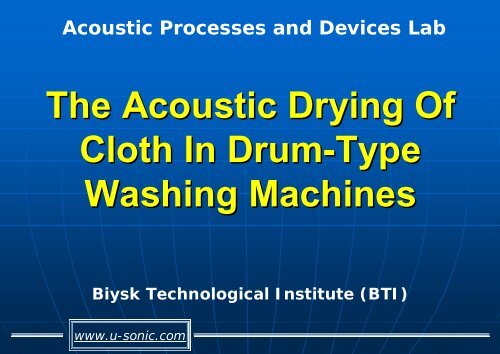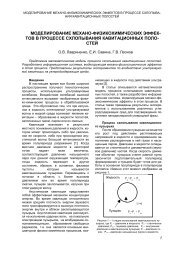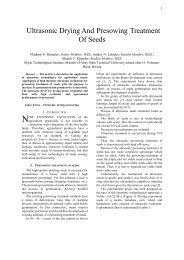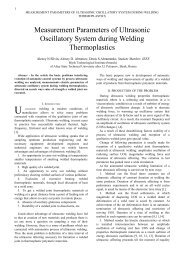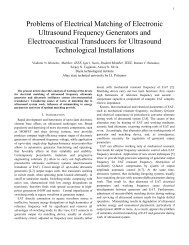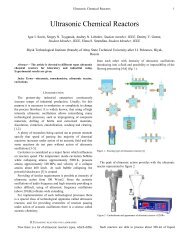The Acoustic Drying Of Cloth In Drum-Type Washing Machines
The Acoustic Drying Of Cloth In Drum-Type Washing Machines
The Acoustic Drying Of Cloth In Drum-Type Washing Machines
Create successful ePaper yourself
Turn your PDF publications into a flip-book with our unique Google optimized e-Paper software.
<strong>Acoustic</strong> Processes and Devices Lab<br />
<strong>The</strong> <strong>Acoustic</strong> <strong>Drying</strong> <strong>Of</strong><br />
<strong>Cloth</strong> <strong>In</strong> <strong>Drum</strong>-<strong>Type</strong><br />
<strong>Washing</strong> <strong>Machines</strong><br />
Biysk Technological <strong>In</strong>stitute (BTI)<br />
www.u-sonic.com
<strong>Drying</strong><br />
<strong>The</strong> drying is a final stage of every cloth washing<br />
processes. Combining washing and drying process in<br />
unified machine provides full automation of cloth<br />
maintenance process at home<br />
Imperfections of<br />
convective drying:<br />
•Long time and big<br />
power consumption.<br />
•Limited minimal size of<br />
washing machine.<br />
•Impossibly to dry<br />
“delicate” cloths.<br />
•Probability of parch of<br />
garments.<br />
Humidity<br />
Comparison<br />
characteristics of<br />
different drying<br />
methods<br />
Key advantages of<br />
acoustic drying:<br />
•Decreasing power<br />
consumption.<br />
•Possibility to carry<br />
out qualitative cloth<br />
drying with low<br />
temperature .<br />
Ultrasound Convection VHF<br />
Time<br />
2
Conceptions <strong>Of</strong> <strong>Acoustic</strong> <strong>Drying</strong> Physical<br />
Mechanism<br />
• At present day uniform conception of<br />
acoustic drying physical mechanism is<br />
absent, but exists set of hypothesis: by<br />
Boucher, by Soloff, , by Greguss. . Each taken<br />
separately it is enough describes some<br />
mechanisms.<br />
• This hypothesizes are based on knowledge<br />
about physical effects that taking place in<br />
drying materials and in material-air<br />
air<br />
interface under high-intensity intensity acoustic<br />
wave propagation. This effects are driving<br />
forces of acoustic drying.<br />
3
Driving Forces <strong>Of</strong> <strong>Acoustic</strong> (Ultrasound)<br />
<strong>Drying</strong><br />
Driving forces<br />
Hydrodynamical Mechanical Calorific<br />
<strong>Acoustic</strong><br />
cavitation<br />
Radiation<br />
pressure<br />
<strong>Acoustic</strong> flows<br />
Water atomization<br />
Turbulization and<br />
reducing thickness<br />
of diffusion interface<br />
Sound-capillary<br />
effect<br />
Pressing-out water<br />
from capillaries<br />
Heating the material<br />
by means of oscillation<br />
absorption<br />
Pressure differences<br />
above material surface<br />
Arising and collapsing<br />
of cavitation bubbles<br />
in capillaries<br />
Pulsation of vapor<br />
in water-free capillaries<br />
Decreasing<br />
liquid viscosity<br />
4
Pressure Differences Above Surface<br />
• <strong>Acoustic</strong> wave, during<br />
propagation above material<br />
surface, arises quickly-changing<br />
changing<br />
zones of increasing and<br />
decreasing pressure.<br />
• Accordingly Boucher hypothesis,<br />
in the increasing pressure zones<br />
drying speed do not decreases,<br />
while in the decreasing pressure<br />
zones arises additional effect of<br />
vacuum drying<br />
<strong>In</strong>creased pressure<br />
Decreased pressure<br />
<strong>In</strong>creased pressure<br />
Decreased pressure<br />
Moisture<br />
5
<strong>Acoustic</strong> Flows <strong>In</strong> Closed Space<br />
• <strong>The</strong> flows in liquid and gas<br />
mediums, during intensity<br />
acoustic wave propagation, are<br />
caused by liquid (gas) viscosity.<br />
• <strong>In</strong>to infinite mediums the acoustic<br />
flows are laminar and directed<br />
lengthways wave propagation<br />
vector.<br />
• <strong>In</strong> the stationary waves conditions<br />
acoustic flows are closed. Near<br />
the interface layer acoustic flows<br />
rises a turbulence.<br />
• <strong>The</strong> velocity of acoustic flows<br />
secondary-degree depends from<br />
sound pressure and in range 140-<br />
150 dB is 6-10 m/s<br />
Scheme of acoustic flows in closed space<br />
<strong>The</strong> acoustic flows is main driving force of acoustic drying in 1401<br />
40-150 dB sound<br />
pressure level range. <strong>Acoustic</strong> flows speeding up evaporation and provides humidity<br />
removal from drying zone<br />
6
Microflows Near Obstacle<br />
• When the acoustic wave interacts<br />
with drying cloth, in immediate<br />
proximity to humidity fibers the<br />
microflows are arises.<br />
• Low intensity waves provides<br />
laminar microflows that do not<br />
influence to drying speed.<br />
• When intensity of acoustic waves<br />
reach a critical value, the<br />
microflows turn into turbulence and<br />
displace a bound laminar flow, that<br />
assists for mass transfer process.<br />
Laminar mode<br />
Re1200<br />
Microflows near the obstacle along with acoustic flows appreciably intensify mass<br />
changes processes at 140-150 150 dB range<br />
7
Reducing Thickness <strong>Of</strong> Water-Air<br />
<strong>In</strong>terface Layer<br />
Air flow<br />
Air flow<br />
Evaporation<br />
Diffusion<br />
<strong>In</strong>terface<br />
Layer<br />
Water<br />
Convective drying<br />
Water<br />
<strong>Acoustic</strong> drying<br />
• Near the wet material surface are presence the interface layer, that is impediment for mass changes<br />
process<br />
• Reducing the interface layer thickness provides increasing the evaporation speed.<br />
• <strong>The</strong> thickness of interface layer depends from diffusion and hydrodynamic processes.<br />
• During the convective drying air flows in interface layer are laminar and thickness of interface layer<br />
defines by diffusion processes<br />
• <strong>In</strong> the high-intensity acoustic fields thickness of interface layer seriously decreases that caused by<br />
turbulent flows and microflows<br />
8
Radiation Pressure<br />
Radiation<br />
pressure<br />
Ultrasound<br />
Removed water<br />
Water in material<br />
• Radiation pressure is steady component of total pressure that influence to<br />
solid in acoustic wave.<br />
• <strong>The</strong> cause of radiation pressure is a transfer a part of wave mechanical<br />
impulse to a solid during absorption or reflection the acoustic wave.<br />
• <strong>The</strong> radiation pressure, that arises in intensity acoustic field (more than 135<br />
dB) capable to squeeze out water drops from material<br />
9
Cavitation<br />
• <strong>The</strong> acoustic cavitation arises in<br />
liquid during propagation high-<br />
intensity acoustic wave.<br />
• <strong>The</strong> cavitation is a key driving<br />
force, that speeding-up many<br />
physiochemical processes in<br />
acoustic fields, includes drying<br />
process.<br />
• <strong>The</strong> cavitation connects with liquid<br />
continuousness violation in<br />
decreased pressure phase, arising<br />
vapor-gas bubbles in gaps and its<br />
collapsing in next increasing<br />
pressure phase.<br />
• When the bubble collapsing, on<br />
account of bubble skewness, , arises<br />
a jet stream that excite micro<br />
shock wave in liquid<br />
<strong>In</strong>creased pressure<br />
Decreased pressure<br />
Decreased pressure<br />
SHOCK WAVES<br />
<strong>In</strong>creased pressure<br />
<strong>In</strong>creased pressure<br />
Decreased pressure<br />
10
Cavitation Atomizing <strong>Of</strong> Liquid<br />
• Collapsing of cavitation bubbles near<br />
free surface excites capillary-gravitation<br />
waves. Wave crests splints up to little<br />
drops.<br />
• Detached drops make up an aerosol.<br />
When other influences (e.g. air flows)<br />
are absent the aerosol is in equilibrium.<br />
• <strong>The</strong> air flows, acoustic flows and<br />
radiation pressure provides effective<br />
removing of aerosol from surface.<br />
• Cavitation atomizing provides water<br />
removal without evaporation. It<br />
decreases power consumption of drying<br />
process<br />
• Cavitation atomizing arises only in<br />
conditions of high cloth humidity<br />
(more than 60%) and high-<br />
intensity ultrasound – more that<br />
160 dB.<br />
• For the cloth drying in washing<br />
machines cavitation atomizing is limited<br />
applicable<br />
Cavitation<br />
Water<br />
aerosol<br />
Capillarygravitation<br />
waves<br />
aerosol<br />
11
Sound-Capillary Effect<br />
• If cavitation bubble arises at<br />
capillary entrance, the shock wave<br />
will be directed into capillary.<br />
• <strong>The</strong> overpressure in capillary, that<br />
excited by shock wave, squeezes<br />
out liquid outside. This<br />
phenomenon named as “soundcapillary<br />
effect”.<br />
• Sound-capillary effect promotes to<br />
accelerated water transfer from<br />
deep layers to surface, that<br />
provides drying speeding up<br />
Water squeeze out<br />
Capillary<br />
Cavitation bubble<br />
12
Pulsation And Explosion <strong>Of</strong> Vapor-gas<br />
Bubbles <strong>In</strong>to Capillaries. Decreasing<br />
Liquid Viscosity<br />
• With a increasing acoustic wave intensity a<br />
part of bubbles does not have a time to<br />
collapse in increasing pressure phase. <strong>In</strong><br />
the next decreasing pressure phase these<br />
bubbles again swell. <strong>The</strong> process may to<br />
repeat continuous time. <strong>The</strong>se bubbles<br />
named as “resonant bubbles”<br />
• Pulsation of resonant bubbles in capillaries<br />
excites low-frequency oscillations of<br />
capillary walls and speeding up water<br />
transfer from deep layers to surface<br />
• Explosions of bubbles into capillary also<br />
promote water transfer process<br />
• Cavitation bubbles provides “loosening” of<br />
liquid and, as result, decreasing the<br />
viscosity, that is additional factor of mass<br />
transfer too.<br />
Water<br />
Water<br />
squeeze out<br />
Borders<br />
vibration<br />
Cavitation<br />
bubbles<br />
13
Effect <strong>Of</strong> Radiation Pressure<br />
Objects “hover” over acoustic radiator<br />
by means of radiation surface<br />
14
Calorific Effect<br />
• Absorption of ultrasonic oscillations<br />
in wet material provides its heating<br />
• <strong>Acoustic</strong> heating arising almost<br />
uniformly on all deepness of<br />
material, that promote water<br />
transfer from deep layers.<br />
• Calorific effect observes only under<br />
high-intensity intensity ultrasonic (more 165<br />
dB) and may be effectively using<br />
for poured materials (e.g. sugar,<br />
corn or silica).<br />
• <strong>In</strong> the acoustic cloth drying calorific<br />
effect show weakly and do not<br />
influence to drying speed<br />
Ultrasound<br />
Heat<br />
Wet material<br />
15
Pulsations <strong>Of</strong> Vapor <strong>In</strong> Water-free<br />
Capillaries<br />
• Due to decreasing humidity, part of<br />
capillaries become water-free.<br />
• <strong>In</strong> the water-free zones a vapor locks<br />
are arising. That fact is a hinder for<br />
transfer humidity remnants to surface.<br />
• High-intensity oscillations excites<br />
pulsations of vapor in water free<br />
capillaries, that breaks a vapor locks.<br />
• Accordingly with Simonian hypothesis,<br />
vapor pulsation and vapor locks<br />
removal provides drying speeding up<br />
Ultrasound<br />
Vapor<br />
squeeze<br />
out<br />
Capillary<br />
16
<strong>In</strong>dustrial Applications <strong>Of</strong> <strong>Acoustic</strong><br />
<strong>Drying</strong><br />
• Low-temperature drying of bioactive<br />
substances<br />
• <strong>Drying</strong> of thermolabile vegetables raw<br />
(corn, mushrooms, herbs)<br />
• <strong>Drying</strong> of flammable and explosive material<br />
• <strong>Drying</strong> of wood<br />
• <strong>Drying</strong> of thermolabile chemical and<br />
medical preparation<br />
• <strong>Drying</strong> of tissues in textile fabrics industry<br />
17
<strong>In</strong>dustrial <strong>Drum</strong>-type <strong>Acoustic</strong> Dryers<br />
• <strong>Drum</strong>-type acoustic dryers are<br />
used for poured materials<br />
drying<br />
• Operation mode of drum-type<br />
dryers is periodical<br />
• Wet material is placed into<br />
drum, where undergo acoustic<br />
influence (including with<br />
heating).<br />
• Rotation of drum promote<br />
uniform acoustic influence<br />
onto all volume of material.<br />
• Wet air from drum-type<br />
dryers removes by airexhauster.<br />
• <strong>Acoustic</strong> field in drum-type<br />
dryers excites by gas-jet<br />
radiators<br />
1 – case, 2 – air-heater, 3 –<br />
chamber, 4 – drum, 5 – door, 6 –<br />
gas-jet radiator, 7 – air-exhauster, 8<br />
-filter<br />
18
<strong>In</strong>dustrial Tunnel-type <strong>Acoustic</strong> Dryers<br />
• <strong>The</strong> tunnel-type<br />
type<br />
dryers, as a opposed<br />
to drum-type<br />
dryers, are<br />
continuous action<br />
apparatus.<br />
• Wet material moves<br />
by transporter<br />
through tunnel,<br />
where presence<br />
high-intensity<br />
intensity<br />
acoustic field<br />
• Tunnel-type dryers<br />
are used for poured<br />
or sheet materials<br />
and also wood<br />
1-wet material, 2– acoustic<br />
radiators, 3- air inlet, 4- air<br />
exhaust<br />
19
<strong>In</strong>dustrial Ellipsoidal-type <strong>Acoustic</strong><br />
Dryers (Project)<br />
• Chamber of ellipsoidal dryers<br />
are generated by truncated<br />
ellipsoid of revolution, at that<br />
revolution axel passing<br />
through one focus of<br />
generatrix ellipse.<br />
• <strong>Acoustic</strong> radiator is allocated<br />
on revolution axel of ellipsoid.<br />
• Wet material allocated along<br />
line that circumscribed by<br />
another generatix ellipse<br />
focus.<br />
• As well known, ellipse collects<br />
in one focus a radiation,<br />
emitting from other focus.<br />
1 - container with wet material, 2 – drying<br />
chamber,<br />
3 – acoustic radiator<br />
20
Contact-<strong>Type</strong> <strong>Acoustic</strong> Dryers<br />
• <strong>In</strong> the contact-type<br />
type<br />
acoustic dryers,<br />
oscillations are<br />
leading into<br />
material under<br />
direct contact with<br />
acoustic radiator.<br />
• Contact-type<br />
type<br />
acoustic dryers are<br />
used for sheet and<br />
roll materials (e.g.<br />
paper, cardboard,<br />
tissues) and wood.<br />
• Contact-type<br />
type<br />
acoustic dryers<br />
based on solid<br />
acoustic radiators<br />
(magnetostrictive<br />
or piezoelectric)<br />
21
Problems <strong>Of</strong> <strong>Acoustic</strong> <strong>Drying</strong><br />
• <strong>In</strong> spite of evident advantages of acoustic drying method<br />
its broad distribution are restrained by set of technical<br />
problems:<br />
1. Low efficiency of existent gas-jet radiators<br />
2. High cost of compressors for pressured air feeding<br />
3. Short life-time of gas-jet radiators<br />
4. Necessity to protection a humans from harmful acoustic<br />
radiation<br />
• Existent constructions of acoustic dryers has been<br />
specified only for industrial applications and absolutely<br />
unfit for household<br />
22
<strong>The</strong> <strong>Acoustic</strong> <strong>Drying</strong> <strong>Of</strong> <strong>Cloth</strong> <strong>In</strong> <strong>Drum</strong>-<br />
<strong>Type</strong> <strong>Washing</strong> <strong>Machines</strong><br />
<strong>Acoustic</strong> <strong>Drying</strong> of <strong>Cloth</strong><br />
in <strong>Drum</strong>-<strong>Type</strong> <strong>Washing</strong><br />
<strong>Machines</strong><br />
Contact method<br />
Noncontact method<br />
<strong>Drum</strong>-walls<br />
oscillations<br />
exciting<br />
Aerodynamically<br />
radiators<br />
Piezoelectric<br />
radiators<br />
Directly<br />
acoustic influence<br />
to cloth<br />
Dynamic<br />
Sirens<br />
Gas-Jet<br />
radiators<br />
23
Gas-Jet Radiators:<br />
Advantages And Imperfections<br />
+ Good acoustic<br />
matching with air<br />
medium<br />
+ Small dimensions<br />
+ Capability to<br />
change working<br />
frequency<br />
- Necessity of high air<br />
flow ratio<br />
- Low efficiency<br />
- Wear of nozzle and<br />
resonator<br />
24
Action <strong>Of</strong> Gas-Jet Radiator To Wet Material<br />
25
Piezoelectric-<strong>Type</strong> Radiator<br />
Advantages<br />
Imperfections.<br />
+ More high effectiveness<br />
in comparison with gas-<br />
jet radiator<br />
+ Simplicity of electronic<br />
generator in mass<br />
production<br />
+ Possibility to focusing<br />
and beam forming<br />
Electronic E; generator<br />
- Complicacy to oscillator<br />
system production<br />
- Necessity to final tuning of<br />
electronic generator with<br />
oscillatory system<br />
- High Q-factor Q<br />
of<br />
piezoelectric radiator<br />
requires special means of<br />
acoustic and electric<br />
matching<br />
- Complicacy<br />
electromechanical<br />
construction<br />
26
Operation Principle <strong>Of</strong> Piezoelectric-type<br />
type<br />
Radiator<br />
Russian patent #2059239,<br />
V.N. Khmelev et. al.<br />
Russian patent #2141386,<br />
V.N. Khmelev et. al.<br />
27
Distribution <strong>Of</strong> Oscillations <strong>Of</strong> Radiating<br />
Surface During Working Frequency Change<br />
28
Piezoelectric-<strong>Type</strong> Radiator<br />
Key features:<br />
Radiating surface diameter,<br />
mm<br />
Weight, kg<br />
Working frequency, kHz<br />
Material:<br />
-of radiating disk<br />
-of acoustic concentrator<br />
<strong>Acoustic</strong> waves intensity in<br />
focus, dB<br />
Focal length, mm<br />
Radiator size<br />
(length*diameter), mm<br />
Cooling<br />
200<br />
1,8<br />
22±1,6<br />
steel 40Х13<br />
titanium alloy BT5<br />
≤200<br />
140..200<br />
150*200<br />
Air, forced by<br />
ventilator<br />
1 – disk, 2 – phase changing<br />
riffles, 3 – oscillatory system<br />
29
Action <strong>Of</strong> Piezoelectric Radiator To Wet<br />
Material<br />
30
Electronic Generator<br />
Electric<br />
Power<br />
<strong>Acoustic</strong><br />
Energy<br />
1 – regulated power supply, 2-output inverter, 3-matching<br />
circuit, 4-oscillatory system, 5-driving oscillator, 6,8,10-<br />
feedback, 7-controller, 9-control panel<br />
Maximal power consumption, W (RMS)<br />
Dimensions, mm<br />
Weight, kg<br />
Working frequency, kHz<br />
Power grid voltage*, V<br />
Output power adjusting range %<br />
* - in mass production may be in 100-240 V range<br />
Key features:<br />
630<br />
250х25<br />
250х110<br />
First Mock-up<br />
(Based On “Vyatka” <strong>Washing</strong> Machine)<br />
Appearance<br />
Gas-jet radiators<br />
Piezoelectric typeradiator<br />
32
Test Procedure<br />
• Testing and comparison gas-jet and piezoelectric-type type radiators.<br />
• Testing possibility to drying different materials.<br />
• Testing soundproofing<br />
<strong>Drying</strong> speed (grams per minute) per weight unit<br />
Pants (wool)<br />
Material<br />
Towel (double)<br />
Thin linen tissue<br />
Sport shirt (cotton)<br />
Gas-Jet radiator<br />
5<br />
5,1<br />
9,5<br />
4<br />
Piezoelectric-type type radiator<br />
13<br />
11<br />
11<br />
8,7<br />
Average speed, gpm<br />
8,2 (7,7)<br />
12,3 (11,6)<br />
33
Obtained Results<br />
<strong>Acoustic</strong> power, W<br />
<strong>Drying</strong> speed, gpm<br />
200<br />
14<br />
12<br />
150<br />
10<br />
100<br />
8<br />
6<br />
50<br />
4<br />
2<br />
0<br />
1GJR<br />
PZT<br />
0<br />
GJR1<br />
PZT<br />
Energy, consumed for removal 1 gram of water, kJ<br />
Consumed power, kW<br />
12<br />
1,6<br />
1,4<br />
10<br />
1,2<br />
8<br />
1<br />
6<br />
4<br />
0,8<br />
0,6<br />
0,4<br />
2<br />
0,2<br />
0<br />
1GJR<br />
PZT<br />
0<br />
GJR 1<br />
PZT<br />
34
Selecting Radiator <strong>Type</strong><br />
Feature<br />
Gas-Jet Radiator<br />
Piezoelectric radiator<br />
Power consumption<br />
≥1000<br />
W<br />
≤500<br />
W<br />
Efficiency<br />
Problems of realization<br />
Cost of acoustic drying<br />
system<br />
Life-time<br />
≤25%<br />
Absence of “domestic”<br />
compressors with high air flow<br />
ratio<br />
10..20$ + compressor cost<br />
≤100<br />
hours<br />
≤50%<br />
none<br />
≤100$ $ in mass production<br />
≥ 1000 hours<br />
Noise level<br />
Over safety level<br />
<strong>In</strong> safety range<br />
Conclusion: Piezoelectric-type radiator is more effective and has<br />
better parameter in comparison with gas-jet radiator<br />
35
Results <strong>Of</strong> Experiments With First Mock-up<br />
(Based On “Vyatka”)<br />
1.Necessity of integrating acoustic radiator into<br />
washing machine with convective drying<br />
system<br />
2.Necessity to make up acoustic drying unit<br />
3.Necessity to investigate soundproofing features<br />
of washing machine<br />
4.Necessity to search optimal drying conditions<br />
For the solving this problem has been build<br />
second mock-up, based on LG WD14124RD<br />
washing machine<br />
36
Second Mock-up, Based On LG<br />
WD14124<br />
14124RD <strong>Washing</strong> Machine<br />
Scheme of mock-up<br />
Appearence<br />
1 – case, 2 – inner drum, 3 – outer drum, 4 – drum drive, 5<br />
–convective drying system, 6 – PZT, 7 – front door, 8 –<br />
case soundproof, 9 – outer drum soundproof, 10 – front<br />
door soundproof<br />
37
Sound Pressure Meter<br />
Standard SPLmeter<br />
Developed<br />
SPL-meter<br />
Imperfections:<br />
Measured SPL – less than 130 dB<br />
Frequency range – less than 20kHz<br />
Single channel<br />
Realized features:<br />
Measured SPL -up to 175 dB<br />
Frequency range – up to 25 kHz<br />
Dual channel<br />
38
Testing Soundproofing System<br />
Scheme of soundproofing system<br />
and SPL measurement<br />
First<br />
channel<br />
SPL-meter<br />
Second<br />
channel<br />
Reducing the level of outside<br />
harmful acoustic radiation and<br />
noise the washing machine was<br />
been soundproofed used special<br />
sound absorption material<br />
SPLAN-8<br />
SPL level into washing<br />
machine and outside was<br />
measured used standard and<br />
developed SPL meters.<br />
Results:<br />
1. Average SPL into drum – 130<br />
dB.<br />
2. Outside SPL at distance 1<br />
meter from washing machine –<br />
less than 70 dB.<br />
* - SPLAN-8 – is a trademark of CG<br />
“Standartplast”, Russia, http://en.stplus.ru/<br />
39
Experimental Studies Method<br />
1. <strong>Drying</strong> same-type tissues samples in different<br />
conditions:<br />
• without ultrasound - temperature 120°С<br />
• without ultrasound - temperature 60°С<br />
• with ultrasound - without heating<br />
• with ultrasound - temperature 120°С<br />
• with ultrasound - temperature 60°С<br />
2. Measuring the humidity over same time intervals.<br />
3. Analysis of results.<br />
40
Experimental Results<br />
(11 kg of cloth, maximal temperture 120°С)<br />
<strong>Drying</strong> speed<br />
<strong>Cloth</strong> humidity dynamics<br />
16<br />
45<br />
15<br />
14<br />
40<br />
<strong>Drying</strong> speed, gpm<br />
13<br />
12<br />
11<br />
10<br />
9<br />
8<br />
w/o US<br />
US var A<br />
US var B<br />
US var C<br />
<strong>Cloth</strong> humidity, %<br />
35<br />
30<br />
25<br />
20<br />
w/o US<br />
US var A<br />
US var B<br />
US var C<br />
7<br />
6<br />
15<br />
0 5 10 15 20 25 30<br />
0 5 10 15 20<br />
Time, minutes<br />
Time, minutes<br />
<strong>Cloth</strong> humidity, %<br />
45<br />
40<br />
35<br />
30<br />
25<br />
<strong>Cloth</strong> humidity dinamics<br />
US var C<br />
w/o US<br />
On the diagrams use following abbreviations: «w/o<br />
US» -without ultrasound influence. «US var A» –<br />
ultrasound influence by PZT #1 (steel acoustic<br />
concentrator), electrical power 330W. «US var B» -<br />
ultrasound influence by PZT #1 (steel acoustic<br />
concentrator), electrical power 500W. «US var C»<br />
ultrasound influence by PZT #2 (titanium acoustic<br />
concentrator), electrical power 250-280W<br />
20<br />
15<br />
0 5 10 15 20 25 30<br />
Time, minutes<br />
41
Experimental Results<br />
(11 kg of cloth, temperature 60°С)<br />
<strong>Drying</strong> speed dynamic<br />
<strong>Cloth</strong> humidity dynamic<br />
10<br />
41<br />
<strong>Drying</strong> speed, gpm<br />
9<br />
8<br />
7<br />
6<br />
5<br />
4<br />
3<br />
2<br />
1<br />
w/o US<br />
US var C<br />
<strong>Cloth</strong> humidity, %<br />
39<br />
37<br />
35<br />
33<br />
31<br />
29<br />
27<br />
w/o US<br />
US<br />
0<br />
0 5 10 15 20 25<br />
25<br />
0 5 10 15 20 25<br />
Time, minutes<br />
Time, minutes<br />
Since the requirements for final cloth humidity are absent, while it is known that exists<br />
optimal humidity for following ironing of cloth and taking into account that equilibrium<br />
humidity of cloth may alternates from 6% to 20% depends from air moisture, WE<br />
SUPPOSES THAT OPTIMAL CLOTH HUMIDITY AFTER DRYING IS 25%<br />
42
Experimental Results<br />
(11 kg of cloth, temperature 60°С)<br />
18<br />
36<br />
16<br />
34<br />
D ry in g s p e e d , g p m<br />
14<br />
12<br />
10<br />
8<br />
6<br />
4<br />
US var C<br />
w/o US<br />
H u m id ity , %<br />
32<br />
30<br />
28<br />
26<br />
24<br />
US var C<br />
w/o US<br />
2<br />
22<br />
0<br />
0 5 10 15 20 25<br />
20<br />
0 5 10 15 20 25<br />
Time, minutes<br />
Time, minutes<br />
Since the requirements for final cloth humidity are absent, while it is known that exists<br />
optimal humidity for following ironing of cloth and taking into account that equilibrium<br />
humidity of cloth may alternates from 6% to 20% depends from air moisture, WE<br />
SUPPOSES THAT OPTIMAL CLOTH HUMIDITY AFTER DRYING IS 25%<br />
43
Experimental Results<br />
(Removing 1 kg of moisture, temperature 120°С)<br />
35<br />
80<br />
30<br />
70<br />
<strong>Drying</strong> speed, gpm<br />
25<br />
20<br />
15<br />
10<br />
US var C<br />
w/o US<br />
<strong>Cloth</strong> humidity, %<br />
60<br />
50<br />
40<br />
30<br />
20<br />
US var C<br />
w/o US<br />
5<br />
10<br />
0<br />
0 10 20 30 40 50 60<br />
Time, minutes<br />
0<br />
0 10 20 30 40 50 60<br />
Time, minutes<br />
<strong>In</strong>fluence<br />
Maximal drying speed,<br />
gpm<br />
Average drying speed,<br />
gpm<br />
<strong>Drying</strong> time<br />
Convective-Heat<br />
24<br />
21,3<br />
47<br />
Combined (convective-<br />
heat + ultrasonic)<br />
29<br />
26,5<br />
39<br />
44
Optimal <strong>Drying</strong> Conditions Selecting<br />
14<br />
12<br />
12<br />
14<br />
10<br />
8,8<br />
9<br />
9,5<br />
9,5<br />
8<br />
6<br />
4<br />
4,4<br />
6,9<br />
6<br />
2<br />
0<br />
1,6<br />
1 2 3 4 5<br />
w/o US<br />
with US<br />
1 – Cold air, 2- Warm air at initial drying period,<br />
3 –Warm air (temperature 60°С), 4 – Hot air (120°C), 5- Hot air<br />
(120°C) + high-power of ultrasonic ( 500 W )<br />
45
Analysis <strong>Of</strong> Experimental Results<br />
1. <strong>Drying</strong> speed with acoustic influence always greater than<br />
drying speed without acoustic influence at same air<br />
temperature and air convection conditions<br />
2. <strong>The</strong> drying speed non-linearly increases depends on<br />
increasing acoustic influence power<br />
3. Maximal drying speed under acoustic influence provides at<br />
initial drying period when cloth humidity is maximal<br />
4. <strong>In</strong> the conditions our experiments maximal drying speed<br />
reach up to 14 gpm at maximal power of PZT 500W<br />
5. Optimal drying speed is 12 gpm (at 350W for “steel” PZT<br />
and 210W of “titanium” PZT)<br />
6. More quick increasing the drying speed at initial period<br />
when using acoustic influence one should be account for non-<br />
inertial character of acoustic influence in comparison with<br />
thermal influence<br />
7. More quick decreasing the drying speed at final period<br />
when using acoustic influence one should be account for more<br />
quick decreasing of cloth humidity.<br />
46
Conclusion<br />
• 1. <strong>The</strong> integration of acoustic drying system into<br />
washing drying machine provides increasing the<br />
drying features by increasing the drying and<br />
decreasing energy consumption.<br />
• 2. <strong>The</strong> energy consumption of drying process<br />
decreases with increasing the acoustic radiation<br />
power.<br />
• 3. Maximal growth of drying speed by acoustic<br />
influence provides on initial drying period when the<br />
cloth and air into drum are cold and cloth humidity is<br />
high.<br />
• 4. <strong>The</strong> most advantages of drying process with<br />
acoustic influence in comparision with drying without<br />
acoustic influence obtains when air temperature in<br />
drum is low.<br />
47


